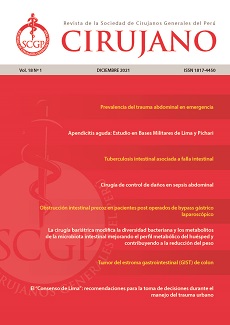Cirugía de control de daños en sepsis abdominal
Keywords:
Damage control surgery, open abdomen, abdominal sepsis, delayed primary anastomosisAbstract
Objective: To describe the characteristics and outcomes of patients undergoing Damage Control Surgery for Abdominal Sepsis in the Emergency Surgery and Surgical Critical Care service of the Guillermo Almenara Irigoyen National Hospital in Lima-Peru. Materials and Methods: Case series of patients undergoing Damage Control Surgery for abdominal sepsis from 2011 to 2017. The inclusion criteria were patients over 18 years of age, abdominal sepsis in septic shock (Multiorgan Failure, APACHE II> 15). Intestinal resection and closure of both intestinal ends (proximal and distal), left inside the abdomen, sing a Temporary Abdomen Closure. The planned relaparotomy was performed within 48 to 72 hours. In this second surgery, a delayed primary anastomosis or delayed primary ostomy was created and the abdomen was definitively closed in one or more relaparotomies. Mortality and complications were evaluated up to 30 days postoperatively. The data were analyzed with the statistical package STATA 11. Results: 17 patients (0.21%) who underwent Damage Control Surgery were recruited from the 8,164 patients operated for emergency in this period. The median was 79 years (26-95 years) and 58.82% were male. 94.11% had at least one comorbidity (diabetes, hypertension, etc.). The median APACHE II score was 26 (16-32). The most frequent diagnosis was intestinal ischemia with perforation (58.82%). 52.94% of the patients were not admitted to the Intensive Care Unit after the first surgery; mortality in them was 24 times higher compared to those who were admitted. 95% of the deaths were attributed to not entering the Intensive Care Unit. In the planned relaparotomy, a delayed primary anastomosis was performed in 37.50% of the cases (corresponding to 83.3% of those admitted to the Intensive Care Unit) and a delayed ostomy in the remainder; 1 patient died before relaparotomy. Global mortality was 47.06% and net mortality 29.41% when causes not related to surgery were excluded (1 patient with Acute Myocardial Infarction and 2 patients with Pulmonary Embolism Thrombus). Conclusions: performance of Damage Control Surgery in selected patients with abdominal sepsis in septic shock is feasible and can reduce mortality and is directly related to resuscitation in the Intensive Care Unit, after the initial surgery which allowed the development of a delayed primary anastomosis in most cases and was associated with lower mortality.
Downloads
Metrics
Downloads
Published
How to Cite
Issue
Section
License
Copyright (c) 2023 Zegarra Cavani, Sergio, Eduardo Huamán Egoavil

This work is licensed under a Creative Commons Attribution 4.0 International License.









